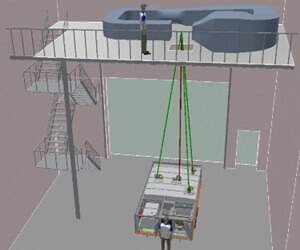Deutsche WindGuard Wind Tunnel Services developed a special wind tunnel for the national metrology institute of Germany (PTB). The wind tunnel will be used to calibrate a LiDAR-System newly developed by PTB. The LiDAR has a high spatial and temporal resolution. It will be used by PTB as a traceable reference standard to calibrate other remote sensing devises, such as LiDARs and SoDARs, in the future.

Schematic representation of the wind-tunnel testing system at PTB’s Competence Center Wind.
The wind tunnel is erected on a platform at a height of eight meters in PTB’s newly finished “Competence Center Wind.” The PTB-LiDAR-System will be positioned below the platform so it can be calibrated in the test section of the wind tunnel. As a result it can be validated as a reference standard. This principle is worldwide unique.
“Constructional limits, as well as our high expectations and sophisticated requirements with regards to flow quality required the design and construction of a new, special wind tunnel,” explained Dr. Harald Müller, Head of the Working Group Fluid Flow Measuring Techniques at PTB. “We chose to work with Deutsche WindGuard, because this way we could access their valuable experience from the development and design of several wind tunnels with excellent flow quality.”
As of now, the method for traceable calibration of wind remote-sensing devices is to place the sensors next to a met mast with calibrated anemometers for a specified amount of time. This leads to higher measurement uncertainties.
“The special feature of this wind tunnel is that the LiDAR can be positioned below the test section. The distance to the test section is enough to calibrate the PTB-LiDAR against a LDA used as reference standard, which is placed in the wind tunnel,” said Dieter Westermann, Managing Director of Deutsche WindGuard Wind Tunnel Services GmbH and developer of the wind tunnel.
Filed Under: News, Sensors




